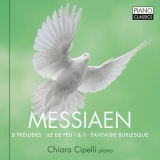 Olivier Messiaen: 8 Préludes + Pièce pour le tombeau de Paul Dukas + Ile de feu I & II + Fantaisie Burlesque; Chiara Cipelli, Klavier; 1 CD Piano Classics PCL 10200; Aufnahme 08/2019, Veröffentlichung 02/2020 (60'23) - Rezension von Remy Franck
Olivier Messiaen: 8 Préludes + Pièce pour le tombeau de Paul Dukas + Ile de feu I & II + Fantaisie Burlesque; Chiara Cipelli, Klavier; 1 CD Piano Classics PCL 10200; Aufnahme 08/2019, Veröffentlichung 02/2020 (60'23) - Rezension von Remy Franck
Frühe und späte Werke von Olivier Messiaen (1908-1992) spielt die italienische Pianistin Chiara Cipelli auf dieser CD von Piano Classics. Das Programm beginnt mit den Huit Préludes, einem Frühwerk von 1928/29, in dem sich noch der Einfluss Claude Debussys zeigt. Messiaen war dieser Zeit noch Schüler von Paul Dukas, für das Messiaen 1936 das Pièce pour le tombeau de Paul Dukas komponierte. Die Burlesque ist noch früher entstanden, nämlich 1932. Cipelli spielt diese Kompositionen kontrastreich und mit jener Vielzahl an Klangfarben, die den Reiz der Musik ausmachen.
In eine andere Welt nimmt uns die Pianistin dann mit den jüngeren Werken mit. Es sind kraftvolle, aber gleichzeitig aber auch sehr phantasievolle Interpretationen dieser beiden Stücke aus Messiaens experimenteller Phase. Sie sind Teil der Quatre études de Rythme, und Ile de feu II gilt als das erste total serielle Stück Messiaens.
Die Rhythmik gelingt Cipelli, ohne dass der Zuhörer die Schwierigkeit des Stücks merkt, was bedeutet, dass die Interpretation über dem Technischen steht.
Bemerkenswert ist die Klangfülle der Einspielung, die für diese Musik ideal räumlich ist.
Early and late works by Olivier Messiaen (1908-1992) are played by the Italian pianist Chiara Cipelli on this Piano Classics CD. The program begins with the Huit Préludes, an early work from 1928/29, in which the influence of Claude Debussy is evident. Messiaen was still a pupil of Paul Dukas at this time, for whom Messiaen composed the Pièce pour le Tombeau de Paul Dukas in 1936. The Burlesque was written even earlier, in 1932. Cipelli is playing these contrasty compositions with the multitude of timbres that make the music so appealing.
The pianist then takes us into another world with the more recent works, delivering powerful but at the same time very imaginative interpretations of these two pieces from Messiaen’s experimental phase. They are part of the Quatre études de Rythme, and Ile de feu II is considered Messiaen’s first totally serial piece.
Cipelli succeeds with the difficult rhythmic structure without the listener noticing the difficulty of the piece, which means that the interpretation takes precedence over the technique.
The recorded sound is ideally spatial for this music.
























